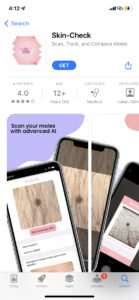Since 1992, the Tulsa Undergraduate Research Challenge (TURC) has enabled undergraduates at The University of Tulsa to conduct advanced research under the guidance of expert professors. The program is a big draw for many students. “TURC was one of the main reasons I wanted to come to TU,” remarked Julian Abhari, one of the program’s recent participants.
In this story, you will meet four TU students and learn about their fascinating TURC projects: Julian Abhari, Caroline Cox, Greysee Floyd and Mark Geisz.
Cancer-detection app
 Mentored by Assistant Professor of Computer Science Vidhyashree Nagaraju, computer science major Julian Abhari created an app called Skin-Check. Abhari’s invention uses artificial intelligence to scan and compare potentially cancerous or suspicious moles, with the aim of detecting skin cancer early and, thereby, reducing the number of related deaths.
Mentored by Assistant Professor of Computer Science Vidhyashree Nagaraju, computer science major Julian Abhari created an app called Skin-Check. Abhari’s invention uses artificial intelligence to scan and compare potentially cancerous or suspicious moles, with the aim of detecting skin cancer early and, thereby, reducing the number of related deaths.
Abhari’s interest in this project had a personal side because his mother had fought her own battle with skin cancer; fortunately, her condition was discovered early. Not everyone, however, is as fortunate. In addition, Abhari knew that many people could not afford regular physician check-ups and the associated laboratory tests. He therefore ensured that his app would be accessible to all free of charge. “Growing up in Tulsa, I’ve seen how our incredibly competitive world leaves many people with serious illnesses without any treatment thanks to high expenses they can’t afford,” Abhari said. His app is an affordable and easy-to-use invention that has the possibility of saving many lives.
Download Skin-Check today from Apple’s App store!
Discovering Renaissance treasures

For her TURC project, art history student Caroline Cox collaborated with Associate Professor of Art History Maria Maurer to locate and identify missing pieces of art in the Philbrook Museum of Art’s Kress Collection, which primarily consists of Italian Renaissance paintings and sculptures.
Cox and Maurer focused their project on altarpiece fragments in a portion of the collection called In Situ, conducting provenance research to find the original location of the work along with its sister panels. Successfully locating all sister panels for two works by Italian painter Domenico Beccafumi won Cox the opportunity to visit other Kress Collections and potentially present her research at several conferences.
Cox and Maurer also brought In Situ to life for museum attendees by digitally reconstructing the altarpiece’s sister panels in addition to the original church in which it resided. Attendees now have the chance to engage with the art as originally intended and therefore understand its beauty and significance more fully.
“We wanted to create a more interactive experience with the artifacts… and educate museum enthusiasts about the work,” said Cox, “because so much is lost when viewing in a traditional museum setting.”
Injury prevention for military personnel
Exercise and sports science student Greysee Floyd and mechanical engineering student Mark Geisz pursued a cutting-edge project designed to reduce the risk of balance-related injuries for military personnel. Under the supervision of Associate Professor of Athletic Training/Exercise Sports Roger Kollock, they worked with subjects who performed a series of jumps and landings while wearing tactical gear, then measured their balance recovery.
The data they collected data enabled them to determine the appropriate load that soldiers should carry in order to land safely and efficiently. “Heavy load carriage is linked to back and lower body injuries in military personnel,” Kollock said. “A greater understanding of how these injuries are caused can help in the development of injury prevention programs. Implementation of effective injury prevention programs can reduce the number of days lost to injury, early-onset bone and joint disease due to injury and overall financial health costs related to injury.”
Geisz recommends the TURC program for others because it allows students to forge strong relationships with professors and students alike while pursuing meaningful research.
Are you interested in engaging deeply with research and expert faculty? If so, consider joining the TURC program! And if you have any questions, send an email to oiel@utulsa.edu.






